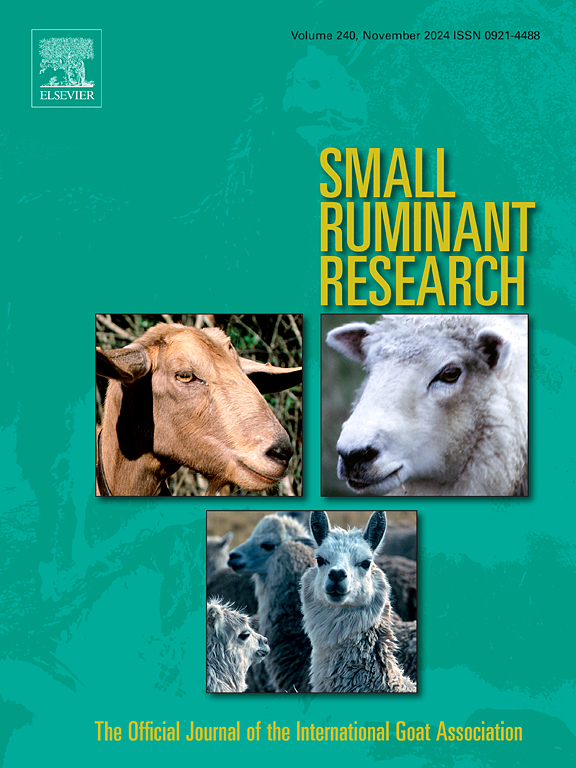小反刍动物慢病毒感染对集约饲养奶羊产奶量和品质性状的影响
IF 1.6
3区 农林科学
Q2 AGRICULTURE, DAIRY & ANIMAL SCIENCE
引用次数: 0
摘要
尽管小反刍慢病毒(SRLV)广泛存在,可引起严重的临床表现,但其对奶羊产奶量的影响仍存在争议。本研究旨在评估SRLV感染对集养奶羊产奶量和品质的影响。随机选择希腊4个受感染的集约化奶羊养殖场的527只纯种希俄斯和拉考恩母羊,在产羔前采用ELISA(血清学检测)和实时PCR(分子检测)检测其感染状况。从断奶后开始,每两个月记录一次产奶量,为期4个月,并对每个牛奶样本进行理化分析(脂肪、蛋白质、乳糖、非脂肪固体)和SCC估计。建立了混合线性回归模型,以评估血清学、分子和感染状态(同时考虑血清学和分子状态)对产奶量的影响。所有农场SRLV感染率超过60% %。虽然血清学状态无显著相关性,但分子状态显示受感染母羊的产奶量降低了10 %。与未感染的母羊相比,感染血清阴性的母羊的产奶量、蛋白质、乳糖和非脂肪固体产量减少了约20% %,脂肪产量减少了12% %,牛奶、蛋白质、乳糖和非脂肪固体产量减少了约15% %,脂肪产量减少了7% %。我们的研究结果支持前瞻性研究设计和分子诊断的重要性,以有效阐明SRLV感染对绵羊生产力的影响。本文章由计算机程序翻译,如有差异,请以英文原文为准。
The impact of small ruminant lentiviruses infections on milk yield and milk quality traits in intensively reared dairy sheep
Despite small ruminant lentiviruses (SRLV) are widespread causing severe clinical manifestations, their effects on milk production in dairy sheep remain controversial. This study aimed to assess the impact of SRLV infections on milk yield and quality in intensively reared dairy sheep. A total of 527 purebred Chios and Lacaune ewes from four infected intensive dairy sheep farms in Greece were randomly selected and their infection status was determined at pre-lambing using both ELISA (serological testing) and real-time PCR (molecular testing). Their milk production was recorded bimonthly for 4 months for one milking period, initiating at the post-weaning, and physicochemical analyses (fat, protein, lactose, solids-not-fat) and estimation of SCC were performed in individual milk samples. Mixed linear regression models were generated for the assessment of the effects of serological, molecular, and infection status (consideration of both serological and molecular status) on milk production. Prevalence rates of SRLV infections exceeded 60 % in all farms. While serological status had no significant association, molecular status revealed a 10 % reduction in milk yield among infected ewes. Infected seronegative ewes had approximately 20 % less milk, protein, lactose and solids-not-fat yields, and 12 % less fat yield compared to the uninfected ones and approximately 15 % decreased milk, protein, lactose, and solids-not-fat yields, and 7 % decreased fat yield compared to the infected seropositive ones. Our findings underpin the significance of prospective study design and molecular diagnosis to efficiently elucidate the impact of SRLV infections on sheep productivity.
求助全文
通过发布文献求助,成功后即可免费获取论文全文。
去求助
来源期刊

Small Ruminant Research
农林科学-奶制品与动物科学
CiteScore
3.10
自引率
11.10%
发文量
210
审稿时长
12.5 weeks
期刊介绍:
Small Ruminant Research publishes original, basic and applied research articles, technical notes, and review articles on research relating to goats, sheep, deer, the New World camelids llama, alpaca, vicuna and guanaco, and the Old World camels.
Topics covered include nutrition, physiology, anatomy, genetics, microbiology, ethology, product technology, socio-economics, management, sustainability and environment, veterinary medicine and husbandry engineering.
 求助内容:
求助内容: 应助结果提醒方式:
应助结果提醒方式:


